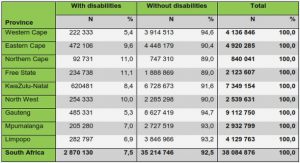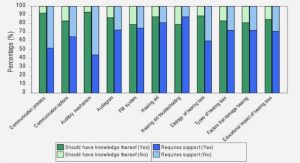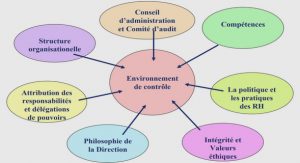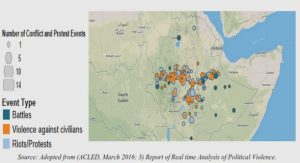Get Complete Project Material File(s) Now! »
Semi-discrete modelling and overview on impulsive differential equations
Mathematical models are description of systems using mathematical language and concepts. Usually, they are composed of relationships between variables, that are abstractions of system parameters that can be quantified. Dynamic models are those that account for time-dependant changes in the state of systems, in opposition to static models. They are typically represented by differential equations or difference equations. The two latter are representative of two classes of dynamical systems. The first class is the class of discrete dynamical systems, in which the variables depend on the time represented by a discrete set. Generally, their form is given by a recurrence relationship : xt+1 = f(xt) (1.1).
The second class is the class of continuous dynamical systems, in which the time flows continuously. Generally, their form is given by : dx = f(t; x) (1.2) dt A third class of systems arises from the two classes above. This is the class of semi-discrete models. Semi-discrete models are hybrid dynamical that undergoes continuous dynamics in ordinary differential equations most of the time and that experiences discrete dynamics at some given time instants [67]. If x denotes the vector of state variables at time t and tk the instants when the discrete changes occur, then a semi-discrete model reads : 8 dt = f(t; x);t 6= tk (1.3) > dx(t) + ) = F (x(tk); tk); < x(t > k : with t+k denoting the instant just after t = tk. f( ) is the continuous ordinary differential equation, possibly time-varying, followed by the system, and F ( ) is the discrete component also termed « pulse ». More generally, we can write an impulsive system as follows [50] : 8 dt = f(t; x); t 6= tk > dx(t) t = tk; x = Ik(x(t)); > > < > t0 0; (1.4).
Singular perturbation theory for slow-fast dynamics
In this appendix, we remind the application of singular perturbation theory for slow-fast dynamics [145, 116]. It leads to the approximation of a high dimensional system by a smaller dimensional system when a very small parameter is assumed to be equal to 0. The smaller dimension system that arises from the full system is the « slow system ». This terminology implies that the zero approximation above assumes the understood « fast dynamics » to be instantaneous.
PhD Thesis : Modelling, analysis and control of plantain plant-parasitic nematodes Consider the system of ordinary differential equations : 8 dx < = f(x; y; t; « ); » dt = g(x; y; t; « ); > dy (1.9) > dt : with x 2 Rm; y 2 Rn; t 2 R, and » is a small positive parameter. Such systems are called singular perturbed systems. The most common approach of the qualitative study of system (1.9) is to consider the following first degenerated system ( » = 0) : 8 dx = f(x; y; t; 0); (1.10) dt > < > 0 = g(x; y; t; 0); : and to drw conclusions about the qualitative behaviour of the full system (1.9) for sufficiently small « . We introduce some definitions and assumptions.
Biology and cultivation of banana and plantain
Banana and plantain are subspecies of the genus Musa [102]. Worldwide, there is no sharp distinction between « bananas » and « plantains ». Especially in the Americas and Europe, « banana » usually refers to soft, sweet, dessert bananas [138], particularly those of the Cavendish group, which are the main exports from banana-growing countries [1]. By contrast, Musa cultivars with firmer, starchier fruit, used for cooking are called « plantains », distinguishing them from dessert bananas. In some regions, many more kinds of banana are grown and eaten, so the binary distinction is not useful and is not made in local languages [138].
The term « banana » is also used as the common name for the plants that produce the fruit. It is a perennial herbaceous plant widely cultivated in the tropical and subtropical regions, and, as a non-seasonal crop, bananas are available fresh year-round. It is perennial because it produces succeeding generations of crops. The first cycle after planting is called the plant crop. The ratoon is the sucker (also called the follower) succeeding the harvested plant. The plant propagates itself by producing such suckers which are outgrowths of the vegetative buds set on the rhizome during leaf formation. During their initial development, the suckers share their parent rhizome [26]. Hence, if the parent plant is infested, so are the suckers [24, 26]. The second cropping cycle after planting is called the first ratoon crop. The third cycle is the second ratoon crop, and so on.
The growth cycle of banana consists of two phases. The vegetative phase (or ’shooting’) begins with the production of leaves by the planted tissue culture plant and ends when the inflorescence appearing at the top of the plant. During this phase, banana produces roots continuously. After it, the absorbed nutrients are essentially directed to the growing of the fruit bunch [6]. The reproductive phase begins with the transition of the vegetative meristem into a floral shoot. The division of phases is arbitrary, and it takes normally about 7-8 months after planting before the inflorescence emerges at the top of the plant [80]. The fruit filling period, that is,the time between flowering and harvest, completes the reproductive phase and the growth cycle.
During the growth cycle, plants develop essentially three major components : an underground corm pro-ducing suckers and roots, a pseudo stem consisting of encircling leaf sheaths and carrying the leaves and an inflorescence, containing female flowers that develop into fruits. At the end of the growth cycle, the fruit bunch is harvested and after harvest, the aerial portions of a banana plant (leaves, pseudostem and fruit stalk) are normally cut down, or else they will die back naturally. The roots that are not involved in the growth of the sucker quickly lose their freshness by senescence [76].
The length of the growth cycle depends on the cultivar. The parent plant and the ratoon are in competi-tion for resources and ratooning is generally followed only in those areas where there is an assured source of irrigation. During the vegetative phase, most of the resources are directed to the growing parent plant. During flowering, ratoon development increases. Hence ratoon management or de-suckering becomes very important. As a rule, a sucker is allowed only after the emergence of the inflorescence in the planted crop and the same package of practices are followed as that of the planted crop before allowing a sucker for the second ratoon. In commercial plantings, usually only one of the suckers is selected to grow out and regenerate the plant [102], in order to keep constant the number of plants by hectare.
In East, West and Central Africa, where most of the world’s plantains are grown, very little attention has been given to them in terms of research. This was evidently because there were no major production problems in the context of limited input and small-scale subsistence farming systems, thus research was not considered a high priority. However, research is now critically important due to the serious threat of black Sigatoka [70], Xanthomonas wilt [136], and banana bunchy top virus (BBTV) [34], as well as rapid yield decline due to banana weevil, poor weed control, poor soil fertility and nematodes.
Biology of Radopholus similis
Radopholus similis is commonly known as the burrowing nematode and belongs to the nematodes phylum, Ty-lenchida order and Pratylenchidae family [117]. It is with, among others, Radopholus kahikateae sp., Radopho-lus nelsonensis sp. nov., Radopholus nativus and R. vacuus, one of the many representatives of the genus Radopholus [105].
Radopholus similis has six life stages: egg, juvenile (4 stages), and adult. The sexual dimorphism is very pronounced in Radopholus similis: the male has a highly developed cephalic cap, thin labial rings, an aborted stylet, a reduced oesophagus and is probably incapable of feeding [143]. On the other hand, females and juveniles have a large stylet with strong basal buttons and thick labial rings. The type specimen is 580 m long by 21 m in diameter [152]. The size and especially the diameter of the adults can indeed vary from one individual to another. In general, males are slightly thinner than females and pregnant females are thicker than young adult females. Examining the offspring of an isolated female, adults can be ranged in size from 580 to 785 m and 22 to 26 m in diameter [142].
Host plants and impact
Since Radopholus similis is one of the most important root pathogens of banana crops [87], it has long been considered to be linked to banana. But in fact, R. similis is able to attack more than 1200 species belonging to many botanical groups [23]. It is an especially important pest of bananas and citrus, and it can be found on coconut, avocado, coffee, sugar cane, other oily, and ornamental. Depending on geographical origins, host weed ranges are highly variable. In Costa Rica, grasses are little or not attacked by R. similis, unlike fabaceae [27]. In Martinique, several grasses, Solanaceae and especially an urticaceae (Phenax sonneratii) are good hosts [99].
When it penetrates the banana root, travels and feeds on the root cortex, R. similis directly destroys cells and also facilitates the entry and development of saprophagous and secondary parasites [7, 63]. At the macroscopic scale, this damages result in the appearance of brown-red necrosis then black (Figure 2.1) [62]. These necroses can develop and cause a decrease in the capacity of the roots to feed the banana. Its growth can therefore be PhD Thesis : Modelling, analysis and control of plantain plant-parasitic nematodes delayed, and its bunches are smaller. In Ivory Coast, yield reductions ranging from 30% to more than 50% have been observed [113, 111].
Necrosis also causes an alteration of the mechanical resistance of the roots. Their ability to maintain anchorage of the plant is then reduced, the risk of toppling (Figure 2.2) is seriously increased [8, 120]. For some authors, the proportion of plants harvested, which depends on the proportion of not fallen plants, is the main yield factor affected by R. similis [16, 14].
The most important damage of R. similis is observed near the bulbs [89]. When they are affected, necrosis develops along the cortex and at the base of strains causing the Black Head Disease (BHD) [62]. These necroses lead often to the toppling of the plant, usually shortly after flowering [8, 120].
Soilborne pest and plant epidemics mathematical models
Gilligan and Kleczkowski proposed two general models for the temporal spread of plant infections basing on a previous model of Gilligan [41], and the model of Walker & Smith [147]. On model deals with root as units, the other with lesions. They are adapted to soilborne epidemics including ectotrophic pathogens and necrotrophic root rotting fungi.
The root model Naming Ni the density of infected roots, N the density of susceptible roots and P the pest inoculum, the Gilligan and Kleczkowski root model is given by the following equation : 8 dN i = (rpP + rsNi)(N Ni); dt > = rnf(N); > dt > : dt = rdP;> in which rn is the rate of root production, rd is the rate of decay of the inoculum, f(N) is a general growth term that incorporates exponential f(N) = N and logistic f(N) = N 1 N=N max growths.
The model of Madden and Van den Bosch [65]
In the early 2000s, Madden and Van den Bosch have developed a coupled differential equation model for the multi-seasonal dynamics of plant disease for annual crops. Their model is an SEIR model of a plant pathogen introduced in an annual cropping system with a semi-discrete formalism. They investigated to what extent plant pathogens may be used as biological weapons, and the conditions under which the pathogen may persist from season to season were given. Naming S the disease free plant individuals, E the latently infected individuals, I the infectious individuals, such that Y = E+I +R is the total diseased individual, and naming P the abundance of pathogen incoculum. The model of Madden and Van den Bosch is given by the following equation : 8 dS > = SP SI; dt dE E; > = SP+ SI < > (3.3) > dt > dt = I; > dR > dR > = ( g0 + 0)P; > dt : where P (0) = P0, S(0) = S0. The constant is the primary infection rate parameter, such that SP is the rate of occurrence of new infections, and S is the mean number of new infected plant individuals produced per unit of inoculum per time. Infectious plants are first in latent state and become infectious at rate . Infectious plants become post-infectious or remove from epidemic at the rate . New infection occur from infectious plants at a rate SI, with being the secondary infection rate parameter. Thus, S is the mean number of new infected individuals per infected individual per time.
The introduced pathogen decays exponentially at a natural mortality rate gP and a depletion rate 0P . In the latter expression, 0 = because each unit of inoculum that produces a plant infection is one less unit of inoculum available for infectiong another plant.
In this model, an epidemic ends at t = Tg, to represent crop harvest. All abundance are set to 0 immediately after the end of the Tg. This is E(Tg+) = I(Tg+) = R(Tg+) = S(Tg+) = 0; where the « + » superscript represents the instant after the end of the season.
Diseased individuals R, I and R produce each an amount of pathogen inoculum at the end of the growing season. If E, I , R represent the amount of pathogen inoculum produced per diseaded individuals, then kE = EE(Tg ), kI = I I(Tg ), kR = RR(Tg ) represent the total amount of inoculum at t = Tg+ from latent, infectious and removed diseased individuals at time t = Tg . Hence, P (Tg+) = kP + kE + kI + kR; kp = P0 exp ( 0 + g)Tg , and the « – » superscript represents the instant before the end of the season.
Table of contents :
I Introduction
II Mathematical Preliminaries
1 Mathematical preliminaries
1.1 Semi-discrete modelling and overview on impulsive differential equations
1.1.1 Floquet theory
1.1.2 Comparison principle
1.2 Singular perturbation theory for slow-fast dynamics
1.3 Random search algorithms
1.3.1 General random search and convergence
1.3.2 Adaptive Random Search on the simplex
III Literature Review
2 Biological background
2.1 Biology and cultivation of banana and plantain
2.2 Biology of Radopholus similis
3 Existing soilborne pest, plant epidemic and crop rotation mathematical models
3.1 Soilborne pest and plant epidemics mathematical models
3.1.1 The model of Gilligan and Kleczkowski [40]
3.1.2 The model of Madden and Van den Bosch [65]
3.1.3 The model of Mailleret et al. [66]
3.1.4 A cohort model adapted to Radopholus similis : the model of Tixier et al.[133]
3.2 Some crop rotation mathematical models
3.2.1 Taylor and Rodrìguez-Kábana’s model of rotation of peanuts and cotton to manage soilborne organisms [127]
3.2.2 The model of Van Den Berg and Rossing [139]
3.2.3 The model of Nilusmas et al. [83]
IV Results and discussion
4 Modelling and analysis of the dynamics of the banana burrowing nematode Radopholus similis in a multi-seasonal framework
4.1 Modelling
4.1.1 Core model
4.1.2 Chemical control model
4.1.3 Fallow deployment model
4.1.4 Well-posedness of the problem
4.2 Analysis and results
4.2.1 Chemical control
4.2.2 Sufficient fallow deployment
4.3 Discussion
4.4 Conclusion
5 Optimal fallow deployment for the sustainable management of Radopholus similis
5.0.1 Yield and profit
5.0.2 Parameter values
5.1 Optimization
5.1.1 Location of the optimal solutions
5.1.2 Optimization algorithm
5.2 Numerical results
5.2.1 Small dimensions
5.2.2 High dimensions
5.2.3 Regulation of high dimension solutions
5.2.4 Comparisons
5.3 Discussion and future work
6 Toward a mixed control strategy
6.1 Optimization problem
6.2 Optimization with fixed-size chains and constant fallow
6.2.1 Resolution
6.2.2 A case study
6.3 Optimization with fixed-size chains and varying fallows
6.3.1 Resolution
6.3.2 A case study
6.4 Conclusion
V Conclusion
VI Bibliography






